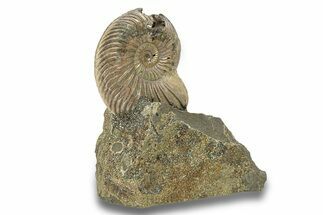2.65" Iridescent Rainbow Pyrite In Septarian Nodule - Russia
This is a gorgeous cluster of druzy pyrite on a piece of septarian concretion, collected near Ulyanovsk Oblast, Russia. These concretions occur in clays that have undergone shrinkage, causing cracks at their centers following dehydration. Septarian concretions often contain calcite, though in some cases they can contain pyrite. The iridescence of the pyrite is natural, only adding to the beauty of this stunning specimen.
The entire specimen is 2.65" wide.
The entire specimen is 2.65" wide.
The mineral pyrite, also known as iron pyrite, is commonly referred to as Fool's Gold because its metallic luster and pale brass-yellow hue give it a superficial resemblance to gold. In the old mining days, pyrite was sometimes mistaken for gold.
It is the most common of the sulfide minerals with the chemical formula FeS2. Pyrite crystals occur in many shapes and habits, including cubes of all sizes, penetration twin cubes, pyritohedral clusters and as small druzy crystals that can exhibit a beautiful glistening effect.
It is the most common of the sulfide minerals with the chemical formula FeS2. Pyrite crystals occur in many shapes and habits, including cubes of all sizes, penetration twin cubes, pyritohedral clusters and as small druzy crystals that can exhibit a beautiful glistening effect.
Septarian or septarian nodules are concretions containing angular cavities or cracks, called "septaria", filled with calcite and aragonite. A concretion is a hard, compact mass of rock that often forms around decaying organic matter. In the case of septarian nodules, the concretions formed around decaying sea-life in a marine environment.
The exact mechanism for how the cracks form in the concretions is a mystery. One possible mechanism is the dehydration of the clay-rich core of a concretion, causing it to shrink and crack. The cracks could also be caused by gas expansion produced by the decaying organic matter within a concretion. Earthquakes have also been suggested as yet another mechanism.
The cracks in the concretions are then filled in with minerals such as calcite (yellow), aragonite (brown), and sometimes pyrite, causing the very interesting patterns. They have often been described as looking like dragon's skin. They are frequently found as geodes with hollow, calcite crystal-filled cavities. More rarely, the fossils that originally started the formation of the concretion are still preserved in the septarian.
The exact mechanism for how the cracks form in the concretions is a mystery. One possible mechanism is the dehydration of the clay-rich core of a concretion, causing it to shrink and crack. The cracks could also be caused by gas expansion produced by the decaying organic matter within a concretion. Earthquakes have also been suggested as yet another mechanism.
The cracks in the concretions are then filled in with minerals such as calcite (yellow), aragonite (brown), and sometimes pyrite, causing the very interesting patterns. They have often been described as looking like dragon's skin. They are frequently found as geodes with hollow, calcite crystal-filled cavities. More rarely, the fossils that originally started the formation of the concretion are still preserved in the septarian.
SPECIES
Pyrite
AGE
LOCATION
Volga River, Ulyanovsk Oblast, Russia
SIZE
2.65 x 1.6" wide
CATEGORY
ITEM
#282541
 Reviews
Reviews









